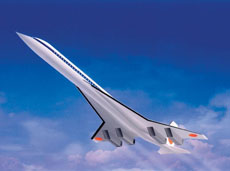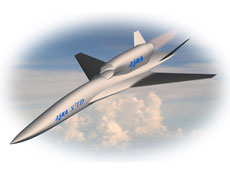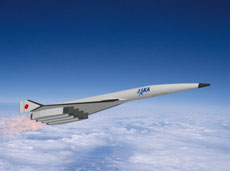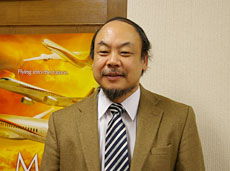

Next generation supersonic passenger aircraft (artist's rendering)
Q. What is the supersonic aircraft JAXA is developing?
It is small aircraft for 30 to 50 passengers. The strength of sonic booms and noise pollution from take-offs and landings will be half that of the Concorde, which was the first and only private supersonic passenger aircraft to date. A sonic boom is an explosive noise caused when the aircraft reaches the speed of sound. Since shock waves from a sonic boom are powerful enough to shatter nearby windows, Concorde aircraft were banned from supersonic flight over lands, and given restricted flight routes. What's more, the airfare was very expensive due to poor fuel efficiency and small capacity of only 100 passengers. Nonetheless, Concorde remained a very attractive transportation method for international business travelers, since it linked Paris and London with New York and Washington, D.C. in only three and a half hours. Concorde's demise was the result of a crash in Paris in 2000, but reportedly its commercial failure was mainly due to the problems of the sonic boom and high fuel consumption.
At JAXA, our goal is to develop environmentally friendly supersonic aircraft with reduced sonic booms and noise pollution. We are also working on improving the fuel efficiency of supersonic aircraft by reducing the aircraft's weight and aerodynamic drag force, which will bring both environmental and economic benefits.

Silent Supersonic Technology Demonstrator (conceptual rendering)
Since we started R&D on supersonic aircraft technology in 1997, we have been conducting concept research on an aircraft fuselage system, and research on elemental technologies including aerodynamics and configuration. Thanks to recent advanced numerical analysis technology, we can now model aircraft design to mitigate aerodynamic drag force and noise. However, as numeric calculation is not enough to prove the credibility of new technologies, naturally, we also test them with a wind tunnel and test flights using a prototype. In 2005, with a scaled supersonic experimental airplane, we successfully validated the airframe design for reducing aerodynamic resistance, and acquired a lot of useful data.
We are also planning to build a silent supersonic technology demonstrator to verify our noise reduction technology. For sonic-boom suppression, while the U.S. has achieved it for only the front part of the airplane, we target the entire body. By the mid 2010s, we hope to accomplish a technology that will drastically reduce of sonic booms, and we hope to build viable supersonic aircraft by the 2020s.
Q. Are supersonic aircraft being developed in other countries as well?
The U.S. and Europe are developing supersonic business jets for up to 20 passengers, but so far no one has managed to substantially reduce the sonic boom. If Japan becomes the first to test this technology successfully, we will be far ahead of everyone else.
No single nation can develop supersonic transport on its own, since this requires an enormous amount of capital and the integration of many advanced technologies. Japan is no exception. Thus, developing core technology for supersonic aircraft will be our ticket to participation in such an international project. For example, Japan was accepted as one of the five participating countries in the V2500 engine project, which sold thousands of units around the world, because our years of research gave us a strong knowledge of engine technology. Similarly, our 30 years of experience in composite material research convinced Boeing to manufacture the main wings of the Boeing 787 in Japan. These accomplishments teach us the importance of choosing the right technologies to focus on. If we don't, Japan will likely not be invited to participate in international projects in the future, which would be a great shame for a nation with such strong support for science and technology.
Supersonic transport will come to fruition sooner or later, but since any substantial revenue is still so far off, it is difficult for private companies to conduct the R&D. Still, many people are interested in this enterprise, and that is why JAXA is exploring these technologies, and bringing in many engineers from the private sector to do the work. I believe that research on cutting-edge and core technologies is something that needs to be done at the national level.

Hypersonic aircraft (artist's rendering)
Q. Once supersonic aircraft are a reality, the next target will be even faster transportation, hypersonic aircraft. How is JAXA preparing for this?
We are currently developing the technology for hypersonic aircraft that will travel at Mach 5 (five times the speed of sound), aiming for completion by 2025. The most challenging part is the engine. In hypersonic flight, a regular engine cannot withstand the heat, which goes up to 1000ºC due to the increase in pressure. So JAXA is exploring pre-cooled turbo engines, which would be able to produce massive thrust by using liquid hydrogen to cool the air entering the engine. This would also make the engine environmentally friendly by greatly reducing carbon dioxide emissions. The static firing test in 2007 was successful, and we are planning a balloon flight test in 2008.

Q. What inspired you to specialize in what you are doing now?
I got interested in airplanes when I was still in elementary school, after reading a book my brother had about the wonder of aviation. I always loved making airplane models as a child. In high school, I began to think about studying aviation at university, and I did. I also took to flying gliders in university, and it happened to be a time of transition for glider construction, changing from wood or steel to fiberglass composite. So I began studying composite materials. In fact, that was the time when people were first starting to hear about carbon fiber composite materials. I spent many years after graduation studying carbon fiber as a composite material in aviation, so I was filled with emotion when I found out about the introduction of carbon fiber composite in passenger aircraft structures, and even more so when I heard that the manufacturer of the material would be the Japanese company I had been working with for a long time.
Q. What is your goal now?
My primary goal is to see the successful development and construction of both clean engines and supersonic aircraft. Personally, I hope that the composite material that I have spent many years researching will flourish beyond its use in aircraft manufacturing, to help reduce CO2 emissions, for example, in other areas. Carbon fiber composite is in fact becoming a popular material in many different fields. I believe that it can contribute to sustainable growth in our society on a large scale, and I must say that its invention is a noteworthy achievement in human history. I sincerely hope that the aerospace technologies JAXA develops will succeed on various fronts, and continue to thrive in the future.
Dr. Takashi Ishikawa
Doctor of Engineering. Director, Aviation Program Group, JAXA
Dr. Ishikawa graduated from the Department of Aeronautics and Astronautics at the University of Tokyo in 1972. Upon receiving his Ph.D. in 1977, he joined the Institute of Space and Astronautical Science (now part of JAXA), and moved to the National Aerospace Laboratory of Japan (now also part of JAXA) the following year. Dr. Ishikawa studied at the University of Delaware in the United States from 1980 to 1982, where he was a visiting associate professor in 1985. From 1995 to 2005, he was a adjunct professor at the University of Tokyo, Nihon University, and Tokyo University of Science. In 2001, he was appointed Director of JAXA's Advanced Composite Technology Center. He has been in his current position since 2005. He is also Vice President of the Japan Society for Aeronautical and Space Sciences.
Doctor of Engineering. Director, Aviation Program Group, JAXA
Dr. Ishikawa graduated from the Department of Aeronautics and Astronautics at the University of Tokyo in 1972. Upon receiving his Ph.D. in 1977, he joined the Institute of Space and Astronautical Science (now part of JAXA), and moved to the National Aerospace Laboratory of Japan (now also part of JAXA) the following year. Dr. Ishikawa studied at the University of Delaware in the United States from 1980 to 1982, where he was a visiting associate professor in 1985. From 1995 to 2005, he was a adjunct professor at the University of Tokyo, Nihon University, and Tokyo University of Science. In 2001, he was appointed Director of JAXA's Advanced Composite Technology Center. He has been in his current position since 2005. He is also Vice President of the Japan Society for Aeronautical and Space Sciences.
Leading Japan's Aviation Industry
JAXA's Initiative for the Development of Clean Engine Technologies in Japan
For Fulfillment of Quiet Supersonic Passenger Aircraft
JAXA's Initiative for the Development of Clean Engine Technologies in Japan
For Fulfillment of Quiet Supersonic Passenger Aircraft